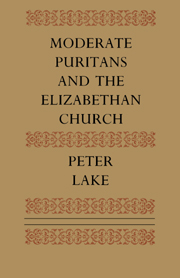Book contents
- Frontmatter
- Contents
- Dedication
- Preface
- 1 Introduction: Laurence Chaderton and the problem of puritanism
- 2 Moderate beginnings: the case of Edward Dering
- 3 Chaderton's puritanism
- 4 The moderate puritan divine as anti-papal polemicist
- 5 Thomas Cartwright: the search for the centre and the threat of separation
- 6 William Whitaker's position as refracted through his anti-papal polemic
- 7 Theory into practice: puritan practical divinity in the 1580s and 1590s
- 8 William Whitaker at St John's: the puritan scholar as administrator
- 9 The theological disputes of the 1590s
- 10 Conformity: Chaderton's response to the Hampton Court Conference
- 11 William Bradshaw: moderation in extremity
- 12 Conclusion
- Notes
- Bibliography
- Index
1 - Introduction: Laurence Chaderton and the problem of puritanism
Published online by Cambridge University Press: 16 October 2009
- Frontmatter
- Contents
- Dedication
- Preface
- 1 Introduction: Laurence Chaderton and the problem of puritanism
- 2 Moderate beginnings: the case of Edward Dering
- 3 Chaderton's puritanism
- 4 The moderate puritan divine as anti-papal polemicist
- 5 Thomas Cartwright: the search for the centre and the threat of separation
- 6 William Whitaker's position as refracted through his anti-papal polemic
- 7 Theory into practice: puritan practical divinity in the 1580s and 1590s
- 8 William Whitaker at St John's: the puritan scholar as administrator
- 9 The theological disputes of the 1590s
- 10 Conformity: Chaderton's response to the Hampton Court Conference
- 11 William Bradshaw: moderation in extremity
- 12 Conclusion
- Notes
- Bibliography
- Index
Summary
Puritanism is normally defined in negative terms. Puritans were people who, with varying degrees of intensity, disliked the Elizabethan settlement. Puritanism was a series of negative gestures directed against that settlement and the church it created. Those gestures could, at the simplest level, express a refusal to become implicated in the allegedly corrupt and corrupting elements in that settlement. Clerical non-conformity can be construed as such a gesture of disassociation from the supposedly popish remnants in the liturgy. These negative gestures, these drives to disassociate the godly elements in the English church from popish corruption, reached their most polemically developed and coherent form in the presbyterian platform. This summed up previous criticisms of the liturgy and polity of the church in terms of a fully developed and supposedly entirely scriptural vision of an alternative church polity. But presbyterianism was not merely a polemical gesture, a significant escalation in the confrontation between defenders of the ecclesiastical status quo and their opponents, it also provided the basis for the classis movement of the 1580s. As Professor Collinson has shown, that movement constituted an attempt to take over the English church by constructing within the existing corrupt and popish shell the very model of a true church. This attempt to set up ‘presbytery within episcopacy’ allowed the members of the classis movement to conceive of themselves as, in some sense, the true representatives of the protestant English church.
- Type
- Chapter
- Information
- Moderate Puritans and the Elizabethan Church , pp. 1 - 15Publisher: Cambridge University PressPrint publication year: 1982



